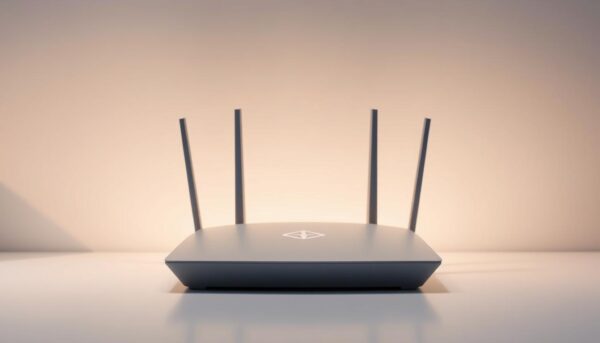✅ Last checked on
Imagine controlling lights, thermostats, and security systems from various manufacturers through one reliable hub. No more juggling apps or dealing with incompatible tech. This isn’t a distant dream—it’s the reality of modern connected living.
The Matter standard changes how devices interact. It creates a unified language for your ecosystem, letting products from Apple, Google, Amazon, and others collaborate securely. You won’t need to replace existing gear; instead, you’ll maximize what you already own.
Why does this matter? Traditional systems often lock you into single brands or expose vulnerabilities. Matter prioritizes interoperability and encryption, ensuring seamless automation without compromising safety. Think of it as a universal translator for your tech.
This guide walks you through configuring a cohesive network. You’ll discover how to centralize control, automate routines, and future-proof your space. Let’s turn fragmented gadgets into a synchronized team.
Key Takeaways
- Matter eliminates brand-specific barriers for cross-compatible device communication
- Existing products can join the network without requiring replacements
- End-to-end encryption ensures safer data handling than older protocols
- Centralized management simplifies control of lights, climate, and security
- Automation rules adapt to daily routines while reducing energy waste
- Setup prioritizes user-friendly configuration over technical complexity
Understanding the Matter Standard for Smart Homes
Fragmented ecosystems used to force users into brand-specific silos. Now, a new connectivity protocol changes everything by letting products from different manufacturers speak the same language. This shift means your existing gear becomes more powerful through collaboration.
An Overview of the Universal Protocol
Developed by the Connectivity Standards Alliance (CSA), this unified protocol simplifies how gadgets interact. It replaces competing standards with a shared framework that works across platforms. You control lights from Brand A through Brand B’s app without complex workarounds.
Advantages of Unified Device Networks
Three core benefits emerge when devices join this standardized network:
- Cross-platform control through your preferred app
- Automatic firmware updates over time
- Encrypted communications between all connected devices
Your network becomes smarter as you add components. A central hub coordinates communication, while Thread border routers extend wireless coverage. This structure reduces latency and prevents single points of failure.
Multi-admin features let household members manage devices through different apps simultaneously. Voice commands and automated routines adapt to daily patterns, creating responsive environments that learn from your habits.
Choosing Your Primary Matter Platform
Your choice of platform shapes how all your devices communicate and collaborate. The right ecosystem acts as your command center, bridging gadgets across brands while maintaining security. Consider existing devices, preferred voice assistants, and long-term scalability when deciding.

Comparing Apple Home, Google Home, Amazon Alexa, and More
Apple Home suits iPhone users deeply invested in the iOS ecosystem. It integrates tightly with HomePods and Apple TVs, which double as Thread border routers. Google Home shines for Android enthusiasts, offering seamless pairing with Nest speakers and Chromecast devices.
Amazon Alexa provides broad third-party device support through Skills. Samsung SmartThings works well for mixed-brand setups, supporting Zigbee and Z-Wave alongside Thread. All platforms now handle Matter-certified products, but controller hardware varies.
Hardware Requirements and Ecosystem Compatibility
Verify your existing hubs. Google Nest Hub (2nd gen) and Amazon Echo 4th Gen include Thread radios. Apple requires a HomePod Mini or latest Apple TV for Thread support. Check if your router handles 2.4GHz and 5GHz Wi-Fi bands simultaneously.
For reliable coverage, ensure at least one Thread border router per 1,500 sq ft. These devices create self-healing mesh networks, reducing dead zones. Update firmware on all components before setup to avoid connectivity hiccups.
Hardware and Hub Requirements for Your Setup
Building a connected ecosystem starts with the right foundation. Dedicated controllers and hubs act as translators between your devices, enabling seamless communication. These components ensure all your gear speaks the same language without conflicts.
Role of Dedicated Controllers
Controllers authenticate and commission new devices through encrypted handshakes. They verify credentials via QR codes or pairing modes, adding layers of security. Without one, you can’t integrate products from different brands into a single network.
Determining the Right Hub
Combination devices simplify setups by merging controller and router functions. Look for models with Thread support to extend wireless coverage automatically. Check manufacturer specs for maximum device limits and update schedules.
| Hub Model | Controller Type | Thread Support | Max Devices |
|---|---|---|---|
| Apple TV 4K | Built-in | Yes | 150 |
| Echo 4th Gen | Dual-mode | Yes | 200 |
| Nest Hub Pro | Standalone | No | 100 |
Separate hubs work best for large spaces needing multiple border routers. Integrated options save counter space but may limit expansion. Always prioritize models with regular firmware updates for long-term reliability.
Networking Essentials: Thread Border Routers and Device Integration
Struggling with weak signals or spotty connections between gadgets? Thread border routers solve this by creating invisible highways for your devices to communicate. These specialized components act as bridges, linking low-power Thread-enabled products to your Wi-Fi network.
Understanding the Function of a Thread Border Router
Thread border routers translate signals between different wireless protocols. They connect battery-operated sensors, lights, and locks using Thread’s energy-efficient mesh while tying them to your primary internet connection. This dual-role operation keeps data flowing smoothly across your entire certified ecosystem.
Most modern hubs include built-in Thread support. For example, popular voice assistants double as border routers when updated to the latest firmware. Devices automatically join the mesh network upon setup, eliminating manual configuration.
Ensuring Reliable Mesh Connectivity
Position border routers centrally to maximize coverage. Each router extends the network’s reach, allowing signals to hop between devices. Plug-in accessories like smart outlets can relay messages, creating self-healing pathways that bypass obstructions.
Use this comparison to choose compatible hardware:
| Model | Protocols | Max Devices | App Integration |
|---|---|---|---|
| Echo 4th Gen | Thread, Zigbee | 200 | Alexa, Others |
| HomePod Mini | Thread Only | 150 | HomeKit |
| Nest Hub Max | Wi-Fi 6 | 100 | Google Home |
Always verify compatibility with your preferred control app before purchasing. Multiple border routers work together to handle larger spaces, automatically balancing traffic loads. Test signal strength in problem areas using your controller’s diagnostic tools.
matter smart home setup: A Step-by-Step Guide
Transform your living space into a seamlessly connected environment using standardized protocols. Follow these instructions to link certified products efficiently while maintaining robust security.
Commissioning Your Devices via QR Codes
Start by locating the QR code on your new gadget. This code contains encrypted credentials for secure pairing. Open your ecosystem’s control app (like Amazon Alexa or Google Home) and:
- Tap “Add Device” in the app’s settings
- Hold your phone 6–8 inches from the QR label
- Wait for the confirmation chime
Devices automatically connect through your router’s 2.4GHz network. If pairing fails, reboot the gadget and ensure Bluetooth is active during setup.
App Integration for Unified Control
After successful pairing, sync third-party apps with your network. Navigate to the manufacturer’s software and:
- Select “Link to Existing System”
- Choose your primary ecosystem
- Authorize data sharing permissions
This bridges features between platforms. For example, a smart lock’s specialized settings remain accessible through its native app while basic controls appear in your central hub.
Troubleshooting Tip: If devices disappear from your network, check router firmware updates. Position border routers closer to problematic areas to strengthen signal reliability.
Setting Up Matter Devices with Google Home and Other Platforms
Unifying gadgets from different brands becomes straightforward when following platform-specific guides. Whether using Google’s ecosystem or alternatives, standardized protocols ensure consistent performance across devices. This process bridges manufacturer guidelines with cross-platform functionality for effortless management.

Step-by-Step Instructions in the Google Home App
Open the Google Home app and tap the “+” icon to begin. Follow these steps:
- Select “Set up device” and choose “New device”
- Scan the QR code using your phone’s camera
- Assign the gadget to a room and confirm its status
If no QR code exists, manually enter the setup key from the product packaging. Most lights and sensors connect within 90 seconds. The app displays a success message once integration completes.
Troubleshooting Common Setup Issues
Persistent problems often stem from connectivity mismatches. Try these solutions:
- Restart your router and controller hub
- Ensure devices operate on 2.4GHz Wi-Fi networks
- Verify manufacturer firmware updates
Platform differences can affect voice command responses. For example, some lights might not dim through Alexa despite working in Google Home. Check compatibility lists before adding non-certified products.
Advanced Configuration: Multi-admin and Device Sharing
Multi-admin features break down the walls between competing platforms. This functionality lets your gadgets respond to commands from multiple ecosystems simultaneously. Picture family members using different apps to adjust the same thermostat or lock—without conflicts or compatibility issues.
Understanding the Multi-Admin Feature
The multi-admin system grants shared ownership of devices across platforms. When you add a lock to your network, for example, it appears in both the Google Home app and Amazon Alexa. Each admin receives unique permissions, ensuring secure access without exposing credentials.
Devices sync status updates in real time. If one user locks a door via Apple Home, others see the change instantly in their preferred app. This works because all platforms communicate through standardized encryption protocols, not proprietary systems.
Best Practices for Seamless Device Sharing
Follow these guidelines to avoid conflicts:
- Ensure all admins connect to the same 2.4GHz internet network during setup
- Update the Google Home app to the latest version for optimal performance
- Assign clear roles (owner vs. guest) to prevent accidental settings changes
For devices like locks, establish priority rules. Most systems process the first received command, ignoring duplicates within a 3-second window. Test scenarios where multiple users interact with the same gadget to refine responsiveness.
Optimize notifications in the Google Home app to track shared device activity. Enable “Status Alerts” under settings to monitor when others adjust temperatures or security features. Regular firmware checks keep all platforms synchronized with the latest security patches.
Automation and Control: Bringing Intelligence to Your Smart Home
Turn your living space into a responsive environment that adapts to your daily patterns. Certified devices work together through standardized protocols, executing commands without manual input. This transforms static gadgets into proactive assistants that anticipate your needs.
Crafting Custom Routines That Adapt
Build automation sequences using triggers from sensors or schedules. In your control app:
- Select “Create Routine” and choose activation conditions
- Pick actions like adjusting lights or locking doors
- Set time delays between multiple commands
Example: Morning coffee starts brewing when motion sensors detect kitchen activity after 6 AM. Lights gradually brighten while your Nest Hub announces the weather.
Voice Commands Meet Local Execution
Say “Hey Google, goodnight” to activate pre-set scenes through your Nest Hub. Commands process locally when possible, reducing cloud dependence.
“Local control cuts response times by 40% compared to cloud-based systems,”
notes a Connectivity Standards Alliance report.
Google integration syncs status across all certified devices. Your thermostat knows when doors open. Lights dim when media plays. These interactions happen through encrypted connections, keeping data private.
Conclusion
Creating a unified ecosystem transforms how your devices work together. By following this guide, you’ve built a network where lights, locks, and sensors collaborate effortlessly. Cross-brand compatibility ensures every gadget contributes to a cohesive experience without requiring replacements.
Stable communication relies on a robust thread network. This backbone handles data securely while letting you use Matter-certified products across platforms. Whether adjusting settings through voice commands or apps, interactions stay responsive and energy-efficient.
Proper integration means your devices work reliably long-term. Regular updates and multi-admin features keep systems adaptable as needs evolve. With encryption built-in, sensitive information remains protected during daily automation.
Ready to enjoy seamless control? Start by exploring advanced IoT networking strategies to refine your setup. Your space now operates as an intuitive, future-ready environment where every device works in harmony.